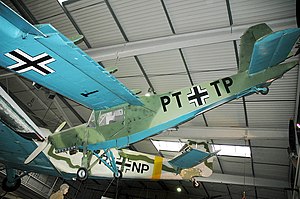Ikarus Kurir
| Kurir | |
|---|---|

| |
| Role | Army liaison, ambulance and parachute aircraft |
| National origin | Republic of Yugoslavia
|
| Manufacturer | Ikarbus, Belgrade |
| Designer | Boris Cijan and Dagoslav Petrovic |
| First flight | 1955 |
| Introduction | 1955 |
| Retired | 1972 (from Yugoslav Air Force service) |
| Primary user | Yugoslav Air Force |
| Produced | 1958-61 |
| Number built | c.145 |
The Ikarus Kurir (English: Courier) is a single-engined high-wing
Design and development
The Kurir was built in a new factory at the old Ikarus site in Zemun, Belgrade, though like all Yugoslav aircraft of the period it was a product of the centralised national design centre.[1] It is sometimes referred to as the Cijan Kurir after one of its designers.
The Kurir has the high wing and tall undercarriage typical of single-engined
The
The Kurir has a fixed, tailwheel undercarriage. The two tall, long-stroke, shock-absorbing main legs mounted on the upper fuselage sides just forward of the cabin have supplementary bracing; each carries a wheel fitted with brakes. Alternatively, skis can be fitted.[1] At least one was configured as a floatplane.
Operational history
About 145 Kurirs were built, serving with the Yugoslav Air Force until 1972.[3] Many were then released for civilian use, mostly appearing on the Yugoslav register and serving in flying clubs. As of July 2010 one Kurir L was registered in the US, one in Slovenia and one in Croatia.
Variants
- Kurir DM-6R: standard production model with DM-6R engine for Yugoslav Air Force.
- Kurir H: floatplane version.
- Kurir L: second series with Lycoming O-435-1.
Operators
Aircraft on display
Two Kurirs, one a Kurir L, are on display in the
Specifications (DM-6R)
Data from [1]
General characteristics
- Crew: 2/3
- Length: 9.68 m (31 ft 9 in)
- Wingspan: 14.9 m (48 ft 11 in)
- Height: 2.5 m (8 ft 2 in)
- Gross weight: 1,400 kg (3,086 lb) two-seat configuration
- Powerplant: 1 × DM-6R air-cooled 6-cylinder inverted inline, geared, 116 kW (155 hp)
- Propellers: 2-bladed , constant speed
Performance
- Maximum speed: 189 km/h (117 mph, 102 kn)
- Cruise speed: 160 km/h (99 mph, 86 kn)
- Range: 760 km (470 mi, 410 nmi)
- Service ceiling: 3,300 m (10,800 ft)
Notable appearances in media
References
- ^ a b c d e f Bridgman, Leonard (1956). Jane's All the World's Aircraft 1956-57. London: Jane's All the World's Aircraft Publishing Co. Ltd. p. 349.
- ^ "Walter/DMB DM-6R". Retrieved 24 July 2016.
- ^ a b "Yugoslav Air Force Aircraft". Archived from the original on 4 July 2013. Retrieved 17 July 2010.
- ^ "Yugoslav Air Force Museum". Retrieved 16 July 2010.
- ^ "Auto & Technik Museum, Sinsheim". Archived from the original on 5 March 2012. Retrieved 16 July 2010.
